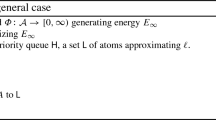Abstract
Normalized Cuts has successfully been applied to a wide range of tasks in computer vision, it is indisputably one of the most popular segmentation algorithms in use today. A number of extensions to this approach have also been proposed, ones that can deal with multiple classes or that can incorporate a priori information in the form of grouping constraints. It was recently shown how a general linearly constrained Normalized Cut problem can be solved. This was done by proving that strong duality holds for the Lagrangian relaxation of such problems. This provides a principled way to perform multi-class partitioning while enforcing any linear constraints exactly.
The Lagrangian relaxation requires the maximization of the algebraically smallest eigenvalue over a one-dimensional matrix sub-space. This is an unconstrained, piece-wise differentiable and concave problem. In this paper we show how to solve this optimization efficiently even for very large-scale problems. The method has been tested on real data with convincing results.
Preview
Unable to display preview. Download preview PDF.
Similar content being viewed by others
References
Rother, C., Kolmogorov, V., Blake, A.: ”GrabCut”: interactive foreground extraction using iterated graph cuts. ACM Transactions on Graphics, 309–314 (2004)
Boykov, Y., Jolly, M.P.: Interactive graph cuts for optimal boundary and region segmentation of objects in n-d images. In: International Conference on Computer Vision, Vancouver, Canada, pp. 05–112 (2001)
Shi, J., Malik, J.: Normalized cuts and image segmentation. IEEE Trans. Pattern Analysis and Machine Intelligence 22(8), 888–905 (2000)
Boykov, Y., Veksler, O., Zabih, R.: Fast approximate energy minimization via graph cuts. IEEE Trans. Pattern Analysis and Machine Intelligence 23(11), 1222–1239 (2001)
Eriksson, A., Olsson, C., Kahl, F.: Normalized cuts revisited: A reformulation for segmentation with linear grouping constraints. In: International Conference on Computer Vision, Rio de Janeiro, Brazil (2007)
Sorensen, D.: Newton’s method with a model trust region modification. SIAM Journal on Nummerical Analysis 19(2), 409–426 (1982)
Eriksson, A., Olsson, C., Kahl, F.: Image segmentation with context. In: Proc. Conf. Scandinavian Conference on Image Analysis, Ahlborg, Denmark (2007)
Olsson, C., Eriksson, A., Kahl, F.: Solving large scale binary quadratic problems: Spectral methods vs. semidefinite programming. In: Proc. Conf. Computer Vision and Pattern Recognition, Mineapolis, USA (2007)
Bazaraa, Sherali, Shetty: Nonlinear Programming, Theory and Algorithms. Wiley, Chichester (2006)
Malik, J., Belongie, S., Leung, T.K., Shi, J.: Contour and texture analysis for image segmentation. International Journal of Computer Vision 43(1), 7–27 (2001)
Author information
Authors and Affiliations
Editor information
Rights and permissions
Copyright information
© 2007 Springer-Verlag Berlin Heidelberg
About this paper
Cite this paper
Eriksson, A.P., Olsson, C., Kahl, F. (2007). Efficiently Solving the Fractional Trust Region Problem. In: Yagi, Y., Kang, S.B., Kweon, I.S., Zha, H. (eds) Computer Vision – ACCV 2007. ACCV 2007. Lecture Notes in Computer Science, vol 4844. Springer, Berlin, Heidelberg. https://doi.org/10.1007/978-3-540-76390-1_78
Download citation
DOI: https://doi.org/10.1007/978-3-540-76390-1_78
Publisher Name: Springer, Berlin, Heidelberg
Print ISBN: 978-3-540-76389-5
Online ISBN: 978-3-540-76390-1
eBook Packages: Computer ScienceComputer Science (R0)




